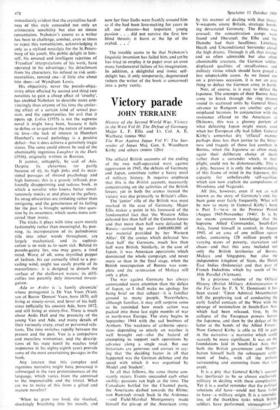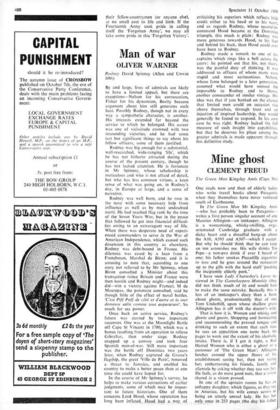Victory parade
JOHN TERRAINE
History of the Second World War. Victory in the West Vol II: The Defeat of Germany Major L. F. Ellis and Lt. Col. A. E. Warhurst (Immo 90s) The War Against Japan Vol V: The Sur- render of Japan Maj. Gen. S. Woodburn Kirby and others (muso 126s) The official British accounts of the ending of the two well-separated wars against aggresssion in 1945, the defeats of Germany and Japan, constitute rather a heavy meal of military history. It requires emphasis that this is the British account, necessarily concentrating on the activities of the British forces; yet in both the arenas treated the victory was due primarily to Britain's allies.
The 'junior' role of the British was most marked in the case of Germany. Major Ellis makes a point in his foreword of the fundamental fact that 'the Western Allies defeated less than half of the German forces and that more than half were defeated by Russia—assisted by over £400,000,000 of war material provided by her Western Allies'. Of the armies which defeated 'less than half' the Germans, much less than half were British. Similarly, in the case of Japan, it was American operations which dominated the whole campaign, and never more so than in the final stage, when the British reoccupation of Burma was com- plete and the re-invasion of Malaya still only a plan.
The war against Germany has always commanded more attention than the defeat of Japan, so I shall make no apology for being brief on that subject—it is familiar ground to many people. Nevertheless, although familiar, it may still surprise some to be reminded how much action was packed into those last eight months of war in north-west Europe. The story begins in September 1944 with the sad business of Arnhem. The weakness of airborne opera- tions depending so utterly on weather is well brought out—also the hazard of attempting to support such operations by advance along a single road. But our historians are generous and comet in say- ing that 'the deciding factor in aH that happened was the German defence and the speed with which it was organised by Model and Student'.
In all that follows, the same theme con- stantly recurs. Events succeeded each other swiftly; passions ran high at the time. The Canadians battled for the Channel ports, the Americans dashed towards the Rhine; von Runstedt struck back in the Ardennes —and Field-Marshal Montgomery made himself the pin-up of the American army by his manner of dealing with that threat. V-weapons smote Britain, strategic bomb- ing devastated Germany. The Rhine was crossed; the concentration camps were found and liberated; the Elbe and the Danube had their headlines; Luneburg Heath and Unconditional Surrender closed the high drama. Through it all, that strange and so often admirable but also often abominable creature, the German soldier, displayed qualities of steadfastness and military virtue which should have graced a less unspeakable cause. As we found out on a previous occasion, it is not an easy thing to defeat the German army in battle.
Nor, of course, is it easy to defeat the Japanese. The attempts of their Burma Area army to break through the ring thrown round its scattered units by General Slinfs advance to Rangoon are another epic of misplaced heroism. In conjunction with the resistance offered to the Americans at Okinawa, this was a gloomy portent of what defeating Japan might mean, even when her European ally had fallen. General Kirby's somewhat dry 'official' manner perhaps does less than justice to the bitter- ness and tragedy of those last combats in Burma, when the Japanese so often made again their deliberate choice of death rather than a surrender which, in their plight, could not be dishonourable. This is a pity, because it is only the understanding of this frame of mind in the Japanese, this capacity for unbelievable self-sacrifice. which can now explain the compulsions of Hiroshima and Nagasaki.
All this, however, even if not as well known as the story of Germany's end, has been gone over fairly frequently. What will be new to many in General Kirby's book is Part 3=SEAC in the Postwar Period (August 1945-November 1946)'. It is by no means common knowledge that the Supreme Allied Commander, South-East Asia, found himself in control, in August 1945, of an area of one million square miles, containing 128 million people in varying states of poverty, starvation and chaos—and that this area included not only the British territories of Burma. Malaya and Singapore, but also the independent kingdom of Siam, the Dutch East Indies (Indonesia) and that part of French Indochina which lay south of the 16th Parallel (Vietnam).
In a previous volume of the Official History (British Military Administration in the Far East by F. S. V. Donnison) it has been stated: 'Upon Admiral Mountbatten fell the perplexing task of conducting the early fateful contacts of the West with the upsurge of nationalism in South-East Asia which had been released, first, by the collapse of the European powers before the Japanese, and then by the defeat of the latter at the hands of the Allied Forces. Now General Kirby is able to fill in gaps in the narrative—a narrative which could scarcely be more significant. It was on the foundations laid in South-East Asia that both the British government and Mount- batten himself built the subsequent settle- ment of India, with all the policies surrounding and stemming from that vast event.
It is a pity that General Kirby's account has (perforce) to be so almost exclusively military in dealing with these complexities. Yet it is a useful reminder that the political solutions did have—could not have failed to have—a military origin. It is a reminder. too, of the thankless tasks which British soldiers have performed, unrecognised _1:5 their fellow-countrymen (or anyone else), at no small cost to life and limb. If the Fourteenth Army took pride in calling itself the 'Forgotten Army', we may all take some pride in this 'Forgotten Victory'.











































 Previous page
Previous page